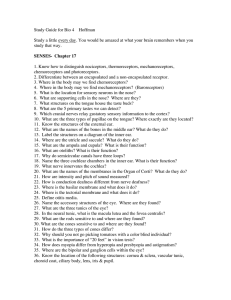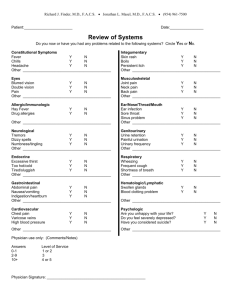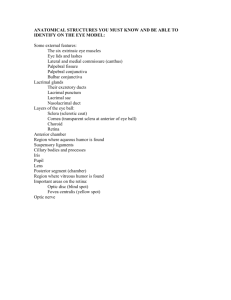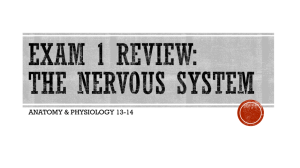Special Senses Spring 2004
advertisement
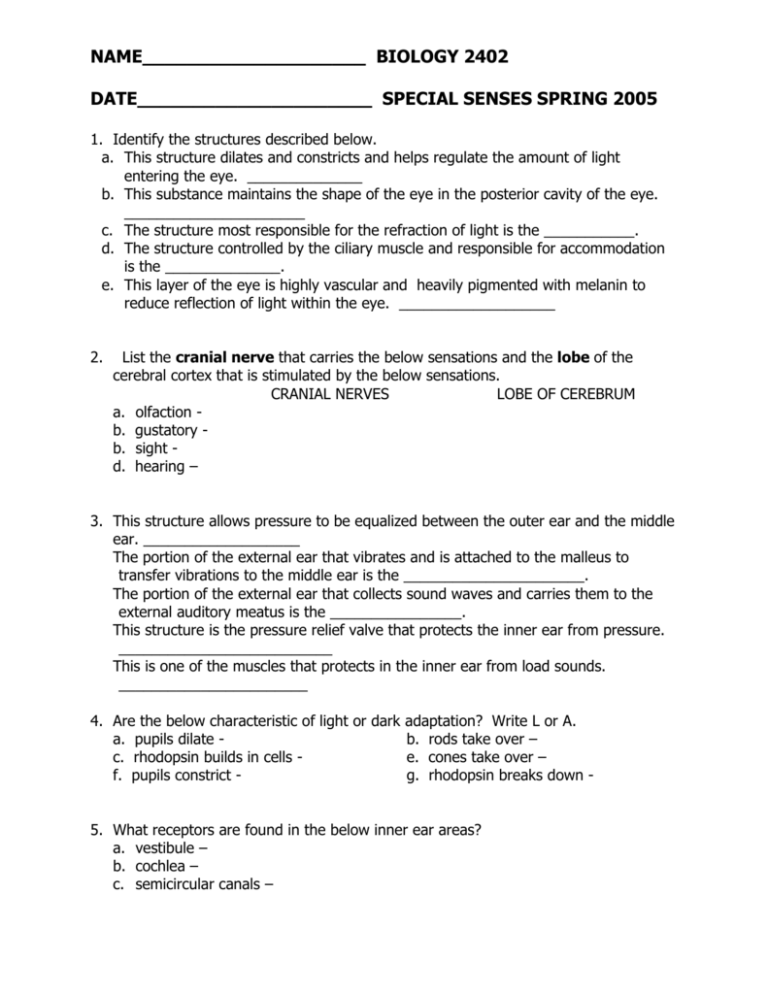
NAME____________________ BIOLOGY 2402 DATE_____________________ SPECIAL SENSES SPRING 2005 1. Identify the structures described below. a. This structure dilates and constricts and helps regulate the amount of light entering the eye. ______________ b. This substance maintains the shape of the eye in the posterior cavity of the eye. ______________________ c. The structure most responsible for the refraction of light is the ___________. d. The structure controlled by the ciliary muscle and responsible for accommodation is the ______________. e. This layer of the eye is highly vascular and heavily pigmented with melanin to reduce reflection of light within the eye. ___________________ 2. List the cranial nerve that carries the below sensations and the lobe of the cerebral cortex that is stimulated by the below sensations. CRANIAL NERVES LOBE OF CEREBRUM a. olfaction b. gustatory b. sight d. hearing – 3. This structure allows pressure to be equalized between the outer ear and the middle ear. ___________________ The portion of the external ear that vibrates and is attached to the malleus to transfer vibrations to the middle ear is the ______________________. The portion of the external ear that collects sound waves and carries them to the external auditory meatus is the ________________. This structure is the pressure relief valve that protects the inner ear from pressure. __________________________ This is one of the muscles that protects in the inner ear from load sounds. _______________________ 4. Are the below characteristic of light or dark adaptation? Write L or A. a. pupils dilate b. rods take over – c. rhodopsin builds in cells e. cones take over – f. pupils constrict g. rhodopsin breaks down 5. What receptors are found in the below inner ear areas? a. vestibule – b. cochlea – c. semicircular canals – 6. The hair cells of the organ of Corti rest on the ____________ membrane and have microvilli that make contact with the_____________ membrane. The hertz range that the human ear responds to is ______________to______________________. 7. This layer of stratified epithelium covers the cornea for protection and when infected results in pink eye. ________________ The ciliary/levator palpebrae superioris/obicularis oculi muscle closes the eye. The optic disc/fovea is made up primarily of cones. 8. Are the below characteristic of rods and cones? Write C or R. a. 6 million per eye b. contain rhodopsin – c. color vision d. dim light vision – e. found in the fovea f. photopsin – 9. List the five primary tastes. Why do you not taste when your tongue is dry? 10. The maculae/cristae are involved in equilibrium when the head and body are moving. It is true/false that the maculae and cristae are proprioceptors. 11. The receptor stimulated during the Romberg test was the ______________. Information from the receptors of the Romberg test are sent to the cochlear/vestibular nuclei. The vestibulospinal/spinocerebellar tracts carry impulses to skeletal muscles from the nuclei stimulated by the special sense proprioceptors. This test was designed to demonstrate the receptors of dynamic/static equilibrium. The muscle spindles and Golgi tendon organs inform the brain of body position by way of the vestibulospinal/spinocerebellar tracts. Bonus. Explain the activities taking place in your body when you stood on one leg in lab and tried to maintain balance. Use in your description the macula, proprioceptors, spinocerebellular tracts, vestibulospinal tracts, and vestibular nuclei.
